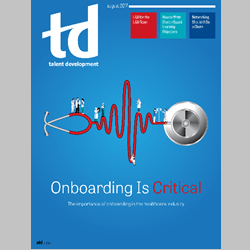TD Magazine Article
A Proper Introduction
Federal agencies that have comprehensive onboarding programs are ahead of agencies that are still conducting only new employee orientation.
Tue Aug 01 2017

Although the federal-wide hiring freeze has been lifted in the United States, many government agencies have remained conservative with resuming their hiring activities. The threat of looming budget cuts for years to come, with estimates of $1.4 trillion over the next 10 years, presents a real need to be cautious as well as strategic.
According to GovExec, "Recruitment, onboarding, training deployment and general support for transportation officers could also run into delays due to an ongoing hiring freeze for all front-line employees." The impact of not having the support staff and comprehensive structure to effectively onboard employees creates additional barriers for newly hired employees to learn the skills, behaviors, attitudes, and knowledge they need to function well on the job.
Federal agencies need to ensure that employees who are hired are ready to perform their duties in the shortest amount of time possible. The best way to facilitate new-employee success is through comprehensive onboarding programs.
According to GovExec, the current administration summarizes the newly proposed budget in this manner: "The spending reductions in this budget are reflective of President Trump's charge to reduce the size of the federal workforce and create a leaner, more accountable, less intrusive, and more effective government."
To accomplish desired outcomes and results, we as learning and development professionals need to shift our approach toward onboarding, which is a process, and away from new employee orientation (NEO), which is an event.
How is NEO different from onboarding?
Onboarding is one of those terms that continues to be misunderstood, especially in the federal government. Many still use the terms onboarding and NEO synonymously, although they are vastly different. To create effective and sustainable onboarding programs, we need to be clear on how the two terms are different.
NEO is a one- or two-day event that is usually led by HR and provides a great deal of information to new employees in a condensed amount of time. After a few days, employees are inserted into their organizations to navigate their new environment with little to no guidance. Most of the time spent during NEO is typically dedicated to completing required forms and listening to presentations from various offices within the department or agency.
Conversely, onboarding is the process of bringing employees into new organizations and roles and ensuring that they have what they need to be successful and productive in the shortest amount of time. Most successful onboarding programs usually last between six months and one year and are facilitated by professionals who focus activities on curating learning, and involve all stakeholders and key players within the organization. Each term has specific and distinguishing characteristics. NEO:
is transactional in nature
usually occurs within the first week
is executed by the HR office
addresses the organization's needs
is focused on completing paperwork.
On the other hand, onboarding:
is strategic in nature
starts before an employee's first day and continues through the first year
involves the employee's supervisor and senior leadership
integrates multiple offices, functions, and individuals
addresses employees' needs
maximizes employee engagement and retention.
Formal onboarding
The best companies create a learning culture for all employees, with a special emphasis on newly hired ones due to the awareness of the high costs of new-hire mistakes.
Research by the Society for Human Resource Management reveals that "half of all hourly workers leave new jobs in the first four months, and half of senior outside hires fail within 18 months." The high costs of replacing newly hired employees is just one reason that successful organizations invest in effective onboarding programs.
Here are a few of the common activities that successful organizations plan:
structure a variety of experiences for new hires
spend more than 16 hours orienting new hires
personally welcome new employees before they arrive
automate processes, checklists, and forms as much as possible
measure success in numerous ways, such as surveys and stay interviews
seek input from newly hired employees based on their onboarding experiences.
In successful organizations, more than 75 percent of new hires participate in formal onboarding. As a result, less than 5 percent of new hires leave during their first year.
Which experience would you prefer?
Consider the different scenarios below and determine which would be better for a new government employee.
Scenario 1. You come in on the first day to a room with 20 new employees. After the fifth presentation by HR, you are asked to fill out 10 forms and take the oath of office. The remaining part of your day is spent in your new office with no computer, phone, or anyone showing you how to get to the cafeteria or restroom. In fact, no one came by your desk except to drop off a manual that you are to read. You meet your supervisor at the end of your first week.
Scenario 2. Before you arrive on the job, you are given access to electronic forms to complete with detailed instructions on how to complete them. In addition, you receive a call from the HR liaison to see if you have any questions before you arrive.
On the first day, you are greeted by someone from your new office who will serve as your onboarding buddy. The person walks you to NEO and asks if you have any questions about the paperwork you were given two weeks before your first day. During the first half of your day, you learn about the organization and how you fit within it, watch a welcome video from your senior leaders, and take a tour of the building by completing a scavenger hunt, followed by a game to test what you've learned
Around noon, your onboarding buddy takes you to lunch, then shows you to your office and introduces you to other members of the staff as well as your supervisor. During an hour-long meeting with your supervisor, you discuss your duties and performance expectations, and developmental opportunities.
During your first two months, your supervisor continues to meet with you weekly. After that, you meet biweekly with your supervisor for the remainder of your first year. Once every month, you go to lunch with your onboarding buddy to discuss how things are going and what additional support you might need. Finally, the onboarding program manager checks in with you monthly and provides opportunities for you and the other new employees to learn and grow within the organization, as well as provide feedback regarding your experience.
When broken down in those two ways, it's easy to see why the second, more comprehensive, scenario would more effectively help new employees become acclimated to their roles, responsibilities, and job duties.
Essential components of onboarding
Federal agencies have to be more strategic and move from a transactional "data dump" to an engaging and positive experience where new employees learn and feel valued before they walk through the door on their first day. Three components are essential to effective onboarding:
Address people needs (create opportunities for new employees to build relationships)
Address organizational needs (help them learn about the organization and how they fit in it)
Provide resources and support needs (provide processes, procedures, policies, resources, and tools to help them do the job).
Creating effective onboarding programs requires careful consideration of desired results and outcomes in the beginning of the process. It shouldn't be done in a silo or from only the HR perspective. To get started:
Identify a program manager.
Assemble a team.
Assess needs.
Create a roadmap.
Develop materials.
Implement a program.
Evaluate successes and failures.
Continuously improve.
It's a journey
Onboarding is all about learning. It must be engaging and fun. Over the years, I've created two successful onboarding programs that engage new employees with two specific purposes.
Passport to Success was created at the department level for newly hired employees. It gives new employees a "passport" on the first day, although they started earning "stamps" prior to that first day. As new employees complete learning activities throughout their first year, they receive additional stamps and "rewards" to celebrate their accomplishments.
The other program is called Pathways to Success. Its purpose is to assist employees who are temporarily joining an organization as participants in the President's Management Council Interagency Rotational Program. New employees receive a game board and fake money for each pathway along their onboarding journey that they complete. At the end, they receive certificates and awards.
It's never too late to build an effective and sustainable onboarding program. Let's ensure that newly hired government employees are prepared and supported to make a contribution to the organization with a comprehensive onboarding program.

